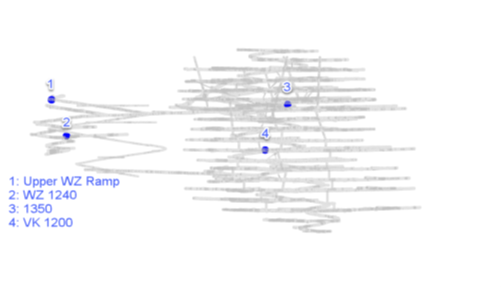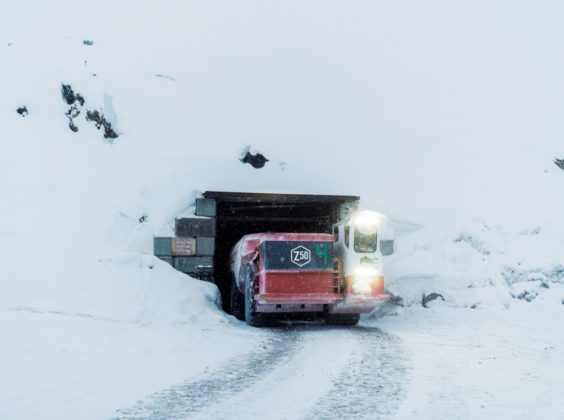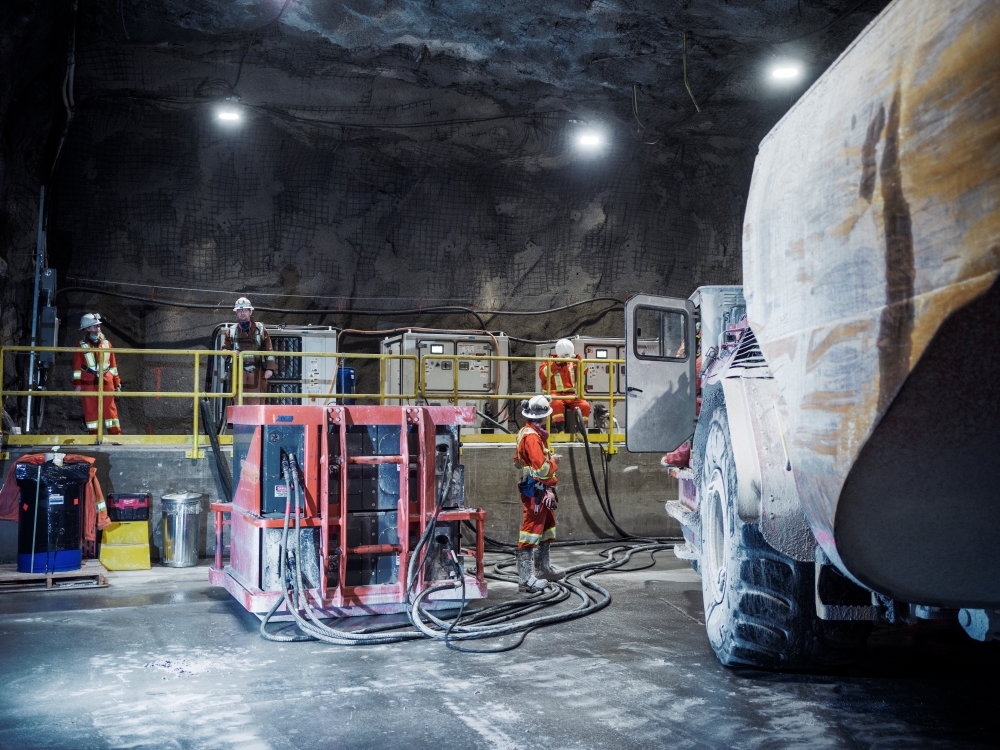A newly published paper from Newmont’s Calen Beaune goes some way to showcasing what it takes to set an underground mine up effectively and efficiently for battery-electric haulage, starting with battery charge bay location.
His paper, ‘Plan vs Actual: A comparison of electric haulage truck charge bay locations (published here),’ details part of the battery-electric journey of the Brucejack gold mine in British Columbia, Canada.
While many would assume the journey started in October 2020 when the first of eight Sandvik Z50 electric haul trucks arrived, it’s clear from Beaune’s paper that the planning for these vehicles commenced a long time before that.
“Initial planning relied on a simulation model that forecast charging needs and optimised fleet sizes over a ten-year period (2022-2033),” Beaune, Brucejack Mine Coordinator, said. “However, several unforeseen challenges led to deviations from the original layout, including power availability, geotechnical constraints and operational considerations related to battery management.”
Plan vs Actual
Brucejack is an underground gold mine that uses a long-hole stoping mining method, with an average of 3,000-4,000 t/d of ore processed.
Materials are trucked from the stope location to a central tipping point at the underground crusher and then conveyed to surface.
The mine extends from 1,500 metres above sea level (masl) to 960 masl with a central ramp connecting each level. A satellite zone (West Zone, WZ) is connected underground but does not yet support stoping activities.
The Sandvik Z50, meanwhile, is a 50-t payload battery-electric truck, and the predecessor to Sandvik’s TH550B trucks. The first truck arrived on site in October 2020, with subsequent trucks arriving approximately every 4-5 months. Brucejack was an early adopter of this technology, serving as an initial – but not the only – location for the development of the Z50.
Charge bays to support the arrival of each addition to the fleet were bolted onto the design: a process that evolved as the company learnt more about the realities of operating this expanding fleet.
Brucejack conducted a simulation study to better understand the optimal layout of charging infrastructure to support implementation of a fully-electric haulage fleet, with this study focusing on establishing the haulage profile as per the mine plan and developing a duty cycle to anticipate battery discharge rates.
“The study identified the location of charging infrastructure and optimised the fleet size to meet production demands,” Beaune said.
An “Arena model” – based on production planning from 2021 to 2033 – resulted in the selection of four locations for the charge bays, noting that the highest trafficked area may require more than one charge bay. The model also calculated battery swaps at each location for periods covering 2022-2027.
“Battery swapping locations were selected based on the highest travelled areas with secondary bays slightly lower in the mine to reduce the risk of running out of battery charge on lower levels,” Beaune clarified.
As these two figures below show, the planned charge bay locations and the actual layout differed somewhat, with Beaune explaining this was a result of “unpredicted considerations that caused deviation from the initial plan.”

One of these was a disconnection between the electrical plan associated with the life of mine (LoM) plan and the realities of operating the incoming Z50 trucks.
“While substations were ordered in advance – as required for level development and charge bay needs – their placement and capacity were not in the Z50 project charter, and locations were not cemented into the LoM plan for capital infrastructure and location designation,” Beaune said. “Further, a misjudged assumption on charge bay design costs required plans to be enacted, which reduced capital by utilising existing development.”
The original project charter also underestimated the capital development required for the charge bay design and additional cables required to connect the charge bays to the load centre, according to Beaune, while the geotechnical support (cable bolts) for the span were also underbudgeted.

The original plan called for a single charging bay to provide a back-up for operators on 1200 Level who did not have sufficient battery life to make a loaded trip from the bottom of the mine to the tipple, according to Beaune, yet, when making the decision on subsequent bays, additional charging bays were installed to ensure operators had numerous options to recharge in the lower mine.
“Detailed battery management planning for trucks was largely an unknown at the time of design, and on-site operator concerns centred around trucks hauling from the lowest parts of the mine – requiring additional charging bays,” he added, explaining the relevance of this concern has proven difficult to measure because operators rarely-to-never-run-out of battery power.
Several developments have aided this decision-making process since the first vehicles arrived in 2020, according to Beaune.
The first bays were designed based on the input and advice of the original equipment manufacturer, Artisan with minimum accessories. In the years since Sandvik’s acquisition of Artisan, the suggested requirements for charge bays have increased to include:
- Ventilation – preferably in a return airway in case of unlikely battery cell-venting;
- Relatively dry- and dust-free areas;
- Cable covers or festoons – alongside cranes for cable movement;
- Concrete floors for reduced maintenance and improved operator safety;
- Drift dimensions 2 m wider than previously recommended (10 m vs 8 m); and
- Shotcrete charging area back over entire charging area
The additional accessories have merit as the alternatives have actualised damage and incidents, according to Beaune.
For battery management planning, trucks are assigned to a dedicated charge bay, Beaune explains, which is handled on a shift-by-shift basis by using trucks associated with charge bays nearest to the truck’s operational area. However, given the spread of the mine and the charge bays, there are instances where a truck will have to make an empty trip to charge batteries. This fact encouraged spacing bays throughout the mine to function as regional chargers for those stopes, but the use of 2-4 trucks per stope results in trucks travelling farther to change batteries, adding to the cycle time.
“This problem is addressed through a program to hot-swap batteries by way of a dispatcher, who can direct trucks to the nearest fully charged battery and obtain additional rigour and oversight on the process to drive efficiency,” Beaune explained.

The addition of charge bays in the lower mine was also driven by a lack of available areas in the centre to place them. Part of this is due to the density of stopes in this area, while part is restricted by a lack of high-density orebody definition at a granular level – additional definition drilling is required to confirm an area is uneconomic to mine before fixed infrastructure is installed, with drilling tending to focus on expanding the resource in high potential areas.
Original charge bay designs were situated near the footwall drive, however positive ore results brought stoping to the intersection in most areas. Therefore, charge bays were situated farther into levels, increasing the time needed for battery swaps.
The layout differences of each bay also come with positives and negatives – there are opportunities to improve safety, cost, maintenance and productivity in the current designs.
“In retrospect, a centralised charging area with all batteries – save for a singular low-mine backup – would be more operationally effective,” Beaune said. “Looking forward, the site is evaluating mobile charge bays to improve flexibility and adaptability to a changing mine plan.”
Typical shifts have averaged two battery swaps per truck per 10-hour shift.
Other operational changes
The Z50 adoption required an expansion in drift widths, from 4.5 m x 4.5 m to 5.5 m x 5.5 m averages, while retaining the smaller Cat AD30 trucks for historical areas. Truck load-out height also increased to 6.5 m. “These challenges are associated with the upgrade in any equipment and have caused minimal issues during transition,” Beaune explained.
A comparison of the outgoing fleet of Cat AD30s with the incoming fleet of Z50s showed that Brucejack realized a 64% t*km increase, with the efficiency gain reaffirming the decision to upgrade the fleet to electric options, Beaune remarked.
The most challenging operational and design issue present involves truck dumping locations, which requires a 7 m high back to safely accommodate the 6.52 m bed height, he noted. Ore-surge remucks at the crusher were expanded by benching, without water flooding issues.
On-level remucks, however, have proven more difficult to plan because the location needed for underground waste dumped from trucks is often sporadic.
This has reduced the efficiency of underground waste deposition but not halted it, Beaune said.

Structured approach
For the charge bay design implementation to be successful, a structured project management approach is required, according to Beaune.
He says a dedicated Projects Manager is required to oversee planning, funding allocation and long-term infrastructure development. Comprehensive feasibility studies and pilot implementations are also required before full-scale deployment.
On top of this, a clear governance structure to ensure all technical, financial and operational considerations were addressed in advance would prove extremely beneficial to any planned rollout. He also urged other mine operators to carry out proactive stakeholder engagement to align the engineering, operations and finance teams from the start.
Finally, robust training and knowledge transfer programs would ensure personnel understood system capabilities and limitations, aiding operational effectiveness.
Challenging and rewarding
The integration of electric haul trucks at the mine has proven to be both a challenging and rewarding process, underscoring the complexities of implementing new technologies in underground mining operations, Beaune says.
Despite the aforementioned setbacks, the project has provided valuable insights into requirements and limitations of electric vehicle infrastructure in the mining sector. The addition of multiple charging bays, the reassessment of battery management protocols and the continuous refinement of design criteria have resulted in a more resilient and efficient charging system.
“Importantly, the lessons learned highlight the need for close collaboration between equipment manufacturers, mine planners and project managers to ensure that infrastructure requirements are fully understood and integrated from the outset,” he said.
The Brucejack experience serves as a case study for future underground mining projects adopting electric haulage systems, emphasising the importance of thorough planning, flexibility in execution and ongoing project management to address the evolving challenges of ambitious technological transitions.
Beaune concluded: “As the mining industry continues to move toward sustainable, electrified solutions, the insights gained at Brucejack will be invaluable in shaping the future of underground electric vehicle infrastructure.”
All photos used in this article were supplied by Sandvik Mining and Rock Solutions and should be credited to photographer Adam Lach











